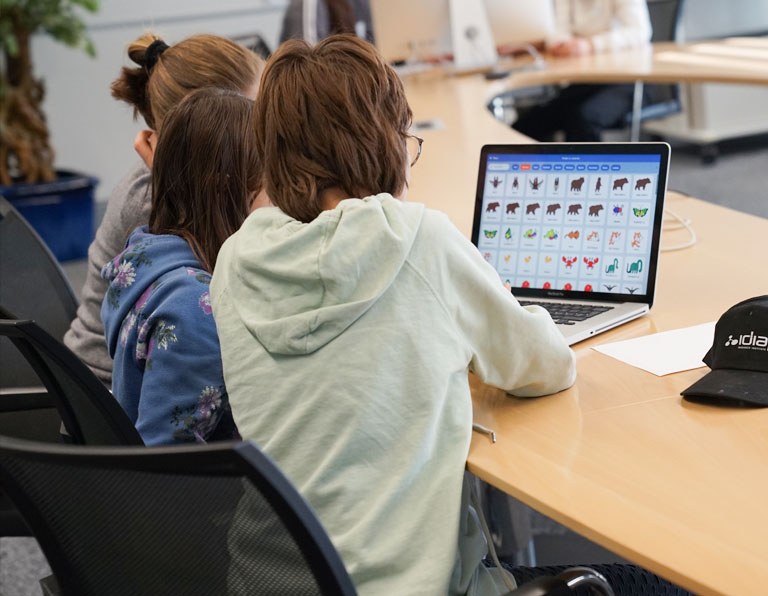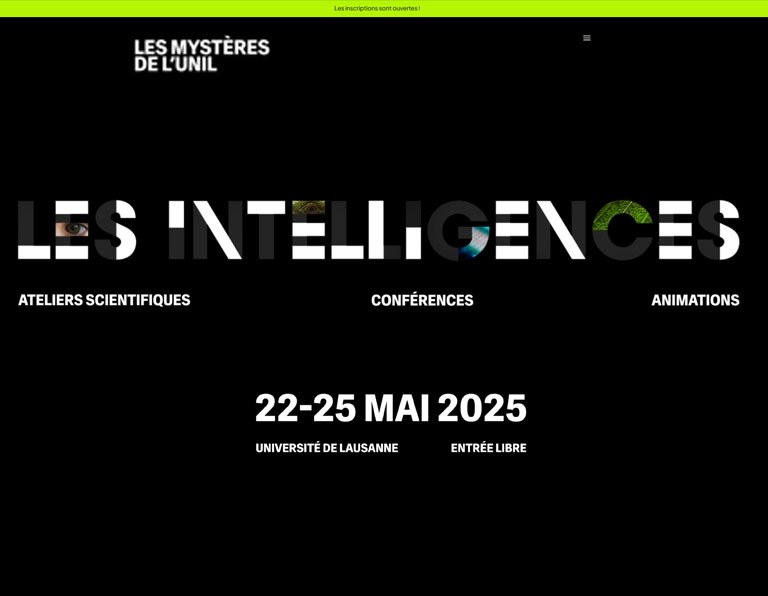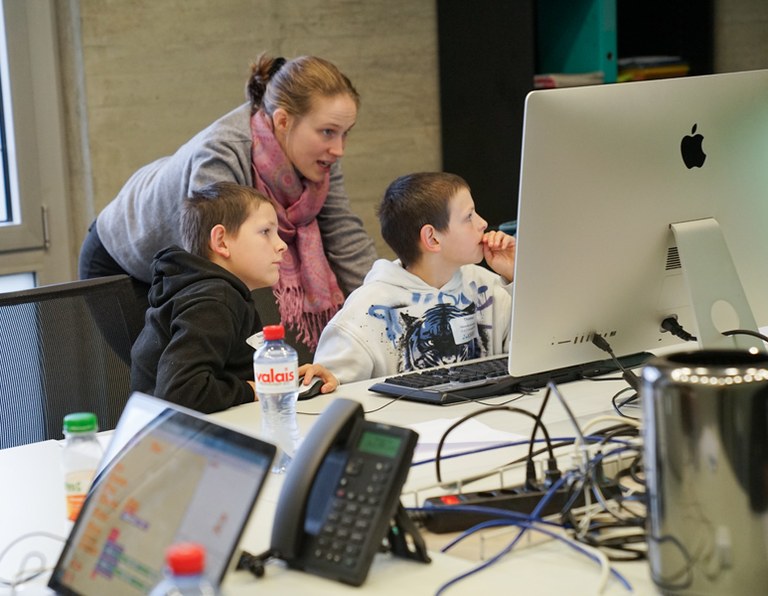Outreach
As part of its educational mission, Idiap also carries out science promotion activities.
November 13, 2025
Every year, we participate in the nationwide 'Future en Tous Genres' day and welcome young explorers aged 12 to dive into the exciting world of science! We are especially passionate about encouraging girls to join the adventure and discover the incredible opportunities a future in science can offer.

May 22-25, 2025
Researchers from UNIL invite you to explore behind the scenes of research and question intelligence in all its forms.

November 14, 2024
Every year, we participate in the nationwide 'Future en Tous Genres' day and welcome young explorers aged 10 to 14 to dive into the exciting world of science! We are especially passionate about encouraging girls to join the adventure and discover the incredible opportunities a future in science can offer.

November 20 & 27, 2024
Following the success of our "Future en Tous Genres" day, we offer additional afternoon sessions to explore the world of science, open to all young explorers aged 10 to 14.

Artificial Intelligence. Our Reflections in the Machine
Extended until September 24, 2023
Brochure - Program
Currently, as part of a Swiss National Science Foundation Agora project, the institute is collaborating with the Musée de la main in Lausanne on an exhibition and mediation activities on artificial intelligence.
Artificial intelligence (AI) is part of our lives and influences our choices. Yet, its capabilities and limits remain difficult to define. The exhibition invites the general public to an interactive discovery of the functioning of AI and its many areas of application. It questions our coexistence with machines capable of performing multiple tasks and solving problems hitherto reserved for humans. By overcoming simplifying preconceptions, it creates a dialogue between interdisciplinary scientific research and artistic installations which, together, question our relationship with AI.
An exhibition created in collaboration with the Idiap Research Institute in Martigny.
The exhibition is recommended for an audience from 10 years old.
Program of activities and events
Aimed at the general public and schools to deepen certain themes presented in the exhibition.
If you wish to be informed about our activities, do not hesitate to subscribe to our monthly newsletter by sending a message to musee.main@hospvd.ch
![cover.jpg Thumbnail [200x250]](https://www.idiap.ch/en/images/cover.jpg/@@images/756e6cee-b4ad-4fa3-8249-e19ae97c6ca3.jpeg)
An example of supervised learning
Idiap, "Computational Bioimaging" Group: Michael Liebling, François Marelli, Florian Piras. With Cindy Leyvraz
In the cameras of our mobile phones or on social media, the use of AI in image processing is common. In scientific and medical imaging, its adoption is delicate and must take into account its limitations. This installation allows the public to train a machine that improves digital images, restoring the shape and color to objects that a poor-quality camera has lost. It includes four key stages of the supervised machine learning process: data acquisition, annotation, machine training, and evaluation. The audience will become aware of the main pitfalls encountered during the implementation of this type of method: insufficient amount of images, lack of diversity, poor annotations, limited computational capacity, and energy hunger.
![Interactif_Idiap_1.jpg Thumbnail [200x250]](https://www.idiap.ch/en/images/interactif_idiap_1.jpg)
Idiap, Biometrics Security & Privacy Group: Sébastien Marcel, Anjith George. With Guillaume Clivaz
Biometrics is the science of identity. The hardware and software technologies being developed in this field aim to distinguish individuals by their unique characteristics (face, iris, fingerprint, etc.). The challenges in this field of research are to design robust tools in the face of variability in morphology over time (for example, aging), to detect attacks such as identity theft, and to secure biometric data to protect privacy. In this exhibition, the public discovers to what extent AI recognizes the face of a mannequin, which they have previously disguised with accessories. This experiment shows that in identification procedures, the threshold from which an identity is considered established is a key concept.
![Interactif_Idiap_2.jpg Thumbnail [200x250]](https://www.idiap.ch/en/images/interactif_idiap_2.jpg/@@images/88028433-d3e4-4593-bfd4-7d3697e90a17.jpeg)
Idiap, "Social Computing" Group: Daniel Gatica-Perez and Benoît Massé. With Philip Abbet
Nowadays, it is possible to teach a machine to detect human behaviors. Head movements, gestures, speech rate and speaking time, tone of voice: a whole chain of reactions is captured and analyzed by an algorithm. These systems are used in psychology research and particularly facilitate interaction with conversational agents. Thus, it is fundamental today to think about the ethical implications of these technologies and to use them only in applications that benefit users without harming them. To understand how behavior analysis by AI works, the audience performs an air guitar performance and discovers which video excerpt from a database it is associated with.
![Interactif_Idiap_3.jpg Thumbnail [200x250]](https://www.idiap.ch/en/images/interactif_idiap_3.jpg/@@images/acc1f5bc-1292-4ec8-9f59-b30e144ffa15.jpeg)
Idiap, 'Perception & Activity Understanding' Group: Jean-Marc Odobez, Rémy Siegfried. With the contribution of Eyeware Tech SA
How is a human analyzed by the machine? The field of research interested in this develops algorithms capable of detecting or estimating, from an image, complex information related to people: position, location of limbs, emotions, gestures, or direction of gaze. Human perception research has many applications. In the medical field, thanks to behavior analysis, it allows the study of motor problems, such as Parkinson's disease, or contributes to the detection of autism or depression. Moreover, it allows us to improve our interactions with electronic devices, making them easier to use for people who are not accustomed to them. In the exhibition, the public will be able to trigger sounds by moving their gaze over an image.
![Interactif_Idiap_4.jpg Thumbnail [200x250]](https://www.idiap.ch/en/images/interactif_idiap_4.jpg/@@images/2b4c8f75-2da2-483b-95a1-f3ada6ed145a.jpeg)
Idiap, "Speech & Audio Processing" Group, Philip Garner, Bastian Schnell. With Colombine Verzat
In the field of speech technologies, more precisely in that of voice recognition and synthesis, one of the goals is to allow a computer to interact with a person in as natural a way as possible for the latter. The challenges are not about what is said, but how it is said. The aim is to achieve expressive speech that conveys emotions, for example when it comes to translating a text with the same emphasis and affects as in the original language. In the future, emotional voice synthesis may allow machines to adapt to their users. The audience is invited to listen to six sentences spoken in English and guess which emotion the AI has attempted to imitate.
![Interactif_Idiap_5.jpg Thumbnail [200x250]](https://www.idiap.ch/en/images/interactif_idiap_5.jpg/@@images/5a616c10-1823-4b5e-96e6-8916e068f742.jpeg)
Idiap, "Robot Learning & Interaction" Group: Sylvain Calinon and Tobias Löw. With Jérémy Maceiras
Support: Franka Emika – The Robotics Company GmbH and Gimelli Engineering AG
The development of robots capable of acquiring skills from demonstrations and interactions with humans makes task transfers from a person to a device easier. The machine no longer learns solely through computer language, but accumulates sensory information that is transmitted to it, for example, through gesture. By physically guiding the robot's arm, the latter learns to replicate movements and adapt them to different situations. These approaches can then be used as much with robots close to us (assistance, industry, prosthetics, exoskeletons) as with distant robots (teleoperation). This device shows how a robotic arm draws a portrait, following a learning focused on insertion tasks.
![Interactif_Idiap_6.jpg Thumbnail [200x250]](https://www.idiap.ch/en/images/interactif_idiap_6.jpg/@@images/2e1c774a-9c76-4d01-b589-9ed9d962709a.jpeg)